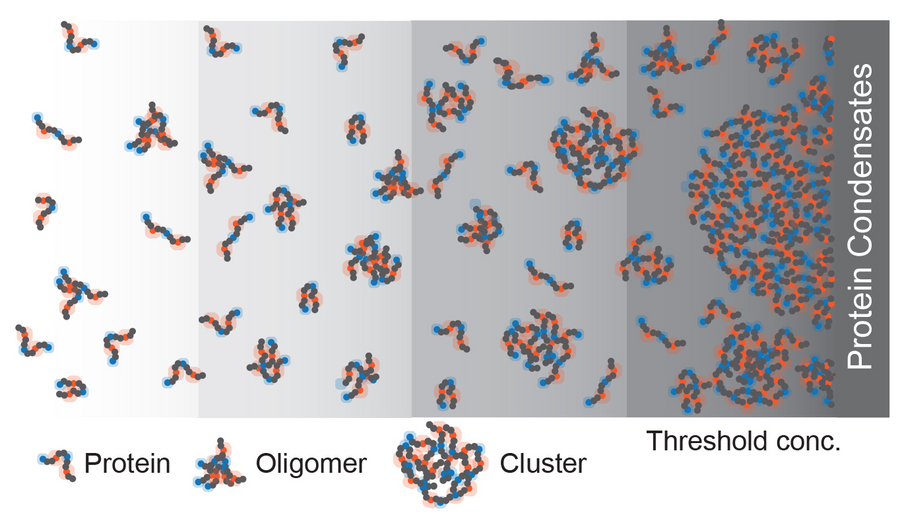
Phase Separation of Proteins. Schematic showing the diverse spectrum of species whose sizes and abundance grow continuously with concentration even below threshold concentration of condensate formation. The grey scale represents the protein concentration. © Mrityunjoy Kar and Rohit Pappu
Every cell contains millions of protein molecules. Some of them have the ability to phase separate to form non-membrane-bound compartments inside the cell, known as biomolecular condensates. The research group of Anthony Hyman, director at the Max Planck Institute of Molecular Cell Biology and Genetics (MPI-CBG) in Dresden, Germany, discovered that these condensates are widespread in biology and that they are relevant to diverse cellular functions. It has been assumed so far that below threshold concentration of phase separation protein remains soluble in solution.
In a current study from the research labs of Anthony Hyman (MPI-CBG) and Rohit Pappu at Washington University in St. Louis, USA, in collaboration with colleagues from the University of Cambridge, Heinrich Heine University Düsseldorf, and Technische Universität Dresden in the journal PNAS, researchers uncovered surprising results in the behavior of key proteins in solutions with ultralow concentrations of phase separating proteins. “In living cells, concentrations of phase-separating proteins are often lower than the measured threshold concentrations required to form condensates. The inference to date has been that these so-called subsaturated or under-saturated solutions feature proteins dispersed as unassembled entities. However, our experiments tell us otherwise. We find, rather surprisingly, that subsaturated solutions include a diverse spectrum of species that we refer to as clusters,” says Mrityunjoy Kar, a researcher in the Hyman lab and lead author of the study, and continues: “The clusters are not biomolecular condensates delineated by a phase boundary.” Furqan Dar, the PhD student in the Pappu lab, adds: “The process of cluster formation, anticipated by theories and computations based on the physics of associative polymers, involves the continuous evolution of cluster sizes and distributions with increasing concentration.”
The function of these protein clusters is still unknown and will be the subject of future studies. “Our findings highlight the totality of species that can form by proteins that are drivers of phase separation. Clearly, the next steps require that we determine the functions of clusters in subsaturated solutions because these concentrations at which they form are relevant in live cells,” says Rohit Pappu. “Knowing that such clusters exist opens the door to assessing their functional relevance,” concludes Anthony Hyman.
Mrityunjoy Kar et al.: Phase-separating RNA-binding proteins form heterogeneous distributions of clusters in subsaturated solutions. PNAS, 05. July 2022